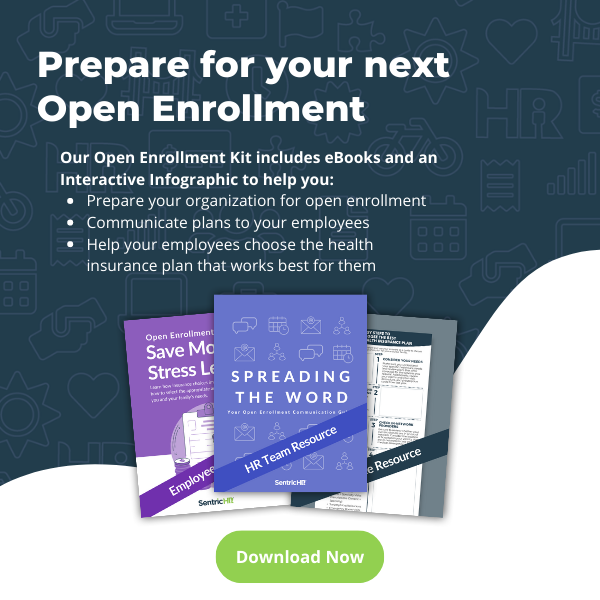Key points:
- Many employees don’t understand what benefits they need
- Benefits rules change every year and are difficult to follow
- An HRIS helps HR teams and employees understand benefits enrollment
When it comes to determining health coverage, open benefits enrollment is the most important time of the year for any employee. In the span of just a few short weeks, they must decide exactly what they need from an insurance provider to keep themselves, their families, and their retirement funds safe.
Unfortunately, the world of benefits isn’t easy to understand. In fact according to Voya, 35% of all American workers don’t understand the options they selected during open benefits enrollment. For millennials, one of the largest demographics in many workplaces, that figure is closer to 54%. HR teams often find themselves teaching their employees about open enrollment, but benefit plans often change from year to year.
Here are the factors to consider when guiding your employees through the benefits enrollment process for 2023:
Best Practices for Open Enrollment
Educating employees is perhaps the single most important thing an HR team can do during, and preferably before, their benefits enrollment period. Voya also found that two-thirds of employees say they want their workplace to help them better understand employee benefits throughout the year, not just during the open enrollment crunch time. Another 73% of employees want guidance tools to better plan their savings for retirement and healthcare expenses.
HR teams should consider translating the often-confusing terminology used by insurance and benefits companies into clear, plain language their employees understand. What is the difference between an individual and family deductible? How about all the different ways to use a health savings account? In order to make the best choices, employees need to understand the basic terms and types of coverage they are likely to encounter.
Sharing all necessary benefit enrollment information through multiple channels, not just a single mass email or an all-day “open enrollment” meeting, is also a good way to ensure everyone on the team is aware. This may mean dividing up presentations into short chunks to cover specific topic areas, like health benefits or retirement planning.
Ultimately, an HR team needs to see themselves as the translators of benefits information for their company—the go-between helping employees understand their benefits so they can make the best decisions possible about their coverage and retirement. Using a Human Resource Information System (HRIS) can amplify your HR team’s efforts by helping them compile, analyze, and present information on your company’s benefits easily and seamlessly.
What To Consider When Preparing for 2023 Open Enrollment
Hybrid and remote workers
Plenty of employees aren’t in the office full-time anymore. These workers aren’t going to be easily available for an all-hands meeting. Ensuring your open enrollment game plan considers both hybrid and remote workers is essential. In this case, an HRIS is the perfect answer. If your HR team uses an HRIS as an all-in-one stop for open enrollment, any one of your employees, no matter where they are located, will feel empowered.
This isn’t just important from an educational angle, either—many employees have differing priorities compared to pre-pandemic years. Supplemental child support, ID-theft protection, and elder care support might be much more important to workers than in previous years.
Benefits competitiveness
In a survey by the American Institute of Certified Public Accountants, four times as many employees favored benefits over a pay raise. Given the ongoing talent shortage, as well as high rates of turnover, HR teams should ensure their benefits options are robust and competitive with the market.
Annual increases in health benefits costs routinely outpace general inflation, and inflation these days is steep. In fact, nearly half of U.S. employees say inflation is making it difficult for them to afford benefits, while 40% say inflation will make them cut back. HR teams should prepare to have difficult conversations with employees about the benefits they’re best able to afford or how they can use their benefits more intelligently.
Feedback for next year
Treating benefits enrollment education as an all-year process means understanding how to improve for the 2024 plan year. HR teams who care about having the best open enrollment possible need to solicit feedback on how to improve.
With the help of an HRIS, HR managers can see which benefits are the most popular among employees, as well as how quickly employees sign up for benefits. Understanding the way employees interact with benefits plans is the first step to designing a better open enrollment preparation process so no one feels confused, left out, or unappreciated.
Important Open Enrollment Updates In 2023
Every year, the IRS updates its rules around benefits, insurance, and retirement contributions. These changes aren’t always easy for HR teams to follow, especially amid all the chaos of open enrollment. These are the most important:
401(k) contribution limit raised. Starting next year, employees can contribute up to $22,500 to their 401(k) plans, with $7,500 extra thrown in for workers 50 and older to catch up with the pack.
Health Flexible Spending Account (FSA) limit raised. Employees will be able to put an extra $200 into their health FSAs next year, double the increases from the past two years. Maximum carryover amounts for unused health FSA amounts are now $610, rather than last year’s $570.
Overall tax brackets raised. The IRS’s federal income tax bracket thresholds all went up by about 7% to compensate for inflation’s toll on income. This could leave more money in workers’ pockets, and potentially allow employees to contribute more to their benefits coverage.
Lowest self-only health premium lowered. As of next year, the lowest self-only health premium cannot be more than 9.12% of an employee’s pay, down from 9.61% in 2022, or $103.28 through the Federal Poverty Line safe harbor.
Health Savings Account (HSA) and high deductible health plan limits raised. Again, thanks to inflation, employees will be able to contribute $200 more for self-only coverage and $450 for family coverage into an HSA.
How an HRIS Can Make Open Benefits Enrollment Easy
With so many benefits options to choose from, employees may not have all the information they need to make an informed decision about next year’s health insurance coverage. Benefits administration software can help employees manage their own benefits and choose the plan that’s right for them, while letting HR conveniently and accurately track their selections in one easy-to-access solution. Speak to a Product Expert about how SentricHR can make open enrollment easy.









